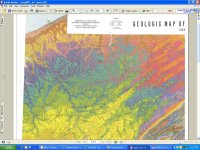I think Pat has a pretty good handle on the situation, although I'd question whether any more statistics gathering or analysis is going to additionally clarify things to any significant degree. It simply is what it is..
If you break the ANF up into three watersheds (Clarion, Tionesta and direct tribs to the river or reservoir within the boundaries of the Forest) the Clarion basin overall has always been the weak sister in terms of being able to produce wild trout as well as in its ability to retain and support stocked fish.
The largest factor in this, from what I understand, is geology. More so than the other ANF watersheds, the Clarion basin is supposedly mostly capped with sandstone with basically no buffering capacity. And while the 1980's and 1990's high visibility of the threats posed by acid deposition has lead to legislation and Clean Air Act enhancements that have to some degree halted or even reversed additional acidification of smaller freestone streams along the Appalachian spine, this doesn't mean that streams that were probably never very good trout habitat anyway are now going to become good trout streams. I tend to think this is the case with a lot of the Clarion basin.
Still, because the main problem is likely geological and because the prevailing geology in a given area is often more like quilt of variable conditions than a solid uniform state, there are always exceptions and as some others have pointed out, they exist in the Clarion watershed as well. There are always a number of streams in the drainage that (if other conditions like scour, sedimentation, summer drought and acid shocks from snow melt, etc. are not too severe) support decent numbers of wild fish and will hold stocked fish fairly well. The upper section of the main stem of Spring Creek and the stream's East Br. have a history of being among these exceptions when other conditions are right. But generally, ANF streams seem to be more prone to boom and bust cycles than the streams in just about any other area of the state when taken as a group. So, often their status as exceptions doesn't last very long. All PA small freestone trout populations wax and wane in response to conditions, but these highs and lows seem to be more abrupt and ephemeral in ANF streams for some reason.
But again, sort of back to Pat's points, you can see the effects of this geological patchwork in all the watersheds of the ANF. In the Tionesta drainage from say Lynch to the Reservoir for example, the streams that enter the creek from the north have historically been better wild trout producers than the ones that enter from the south. And as a group, the north to south flowing tribs of the WB Tionesta, at least those that enter below Chapman Dam, are probably in the top tier of the best wild trout streams in the ANF. Yet the WB itself and its tribs above Chapman Dam are pretty poor and pretty acidic.
So, its all kind of a crap shoot and highly variable. Spring Creek may well be one of the better streams in the Clarion drainage, but it still historically hasn't been a very good trout stream, even by ANF standards.
One last thing.. I tend to think another factor, albeit it of lesser importance than prevailing geology, that hampers trout recruitment in portions of the Clarion watershed is the presence of a fairly dense sand substrate in the middle and upper portions of some of the streams. Bear Creek and Spring Creek both have extensive sections of this substrate, which isn't much good for spawning or supporting a forage base. The once highly acidified (and last I heard, now limestone treated) Mill Creek (near Ridgeway) is another with a lot of sand in the streambed as is, over the hill, much of the South Br. of Tionesta Creek, another mediocre trout stream.
All this, IMO of course...🙂






